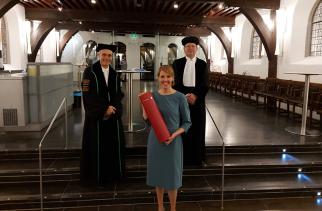Programmaleider Zorgdata en het Lerend Zorgsysteem; bijzonder hoogleraar 'Transparantie in de zorg vanuit patiëntenperspectief', Tranzo, Tilburg University
Publicatie
Publicatie datum
Use of out-of-hours primary care in affluent and deprived neighbourhoods during reforms in long-term care: an observational study from 2013 to 2016.
Jansen, T., Verheij, R.A., Schellevis, F.G., Kunst, A.E. Use of out-of-hours primary care in affluent and deprived neighbourhoods during reforms in long-term care: an observational study from 2013 to 2016. BMJ Open: 2019, 9(3), p. e026426.
Lees online
Objectives
Major long-term care (LTC) reforms in the Netherlands in 2015 may specifically have disadvantaged socioeconomically deprived groups to acquire LTC, possibly impacting the use of acute care. We aimed to demonstrate whether LTC reforms coincided with changes in the use of out-of-hours (OOH) primary care services (PCSs), and to compare changes between deprived versus affluent neighbourhoods.
Design
Ecological observational retrospective study using routinely recorded electronic health records data from 2013 to 2016 and population registry data.
Setting
Data from 15 OOH PCSs participating in the Nivel Primary Care Database (covering approximately 6.5 million inhabitants) in the Netherlands. PCS utilisation data on neighbourhood level were matched with sociodemographic characteristics, including neighbourhood socioeconomic status (SES).
Participants
Electronic health records from 6 120 384 OOH PCS contacts in 2013–2016, aggregated to neighbourhood level.
Outcome measures and analyses
Number of contacts per 1000 inhabitants/year (total, high/low-urgency, night/evening-weekend-holidays, telephone consultations/consultations/home visits). Multilevel linear regression models included neighbourhood (first level), nested within PCS catchment area (second level), to account for between-PCS variation, adjusted for neighbourhood characteristics (for instance: % men/women). Difference-in-difference in time-trends according to neighbourhood SES was assessed with addition of an interaction term to the analysis (year×neighbourhood SES).
Results
Between 2013 and 2016, overall OOH PCS use increased by 6%. Significant increases were observed for high-urgency contacts and contacts during the night. The largest change was observed for the most deprived neighbourhoods (10% compared with 4%–6% in the other neighbourhoods; difference not statistically significant). The increasing trend in OOH PCS use developed practically similar for deprived and affluent neighbourhoods. A a stable gradient reflected more OOH PCS use for each lower stratum of SES.
Conclusions
LTC reforms coincided with an overall increase in OOH PCS use, with nearly similar trends for deprived and affluent neighbourhoods. The results suggest a generalised spill over to OOH PCS following LTC reforms.
Major long-term care (LTC) reforms in the Netherlands in 2015 may specifically have disadvantaged socioeconomically deprived groups to acquire LTC, possibly impacting the use of acute care. We aimed to demonstrate whether LTC reforms coincided with changes in the use of out-of-hours (OOH) primary care services (PCSs), and to compare changes between deprived versus affluent neighbourhoods.
Design
Ecological observational retrospective study using routinely recorded electronic health records data from 2013 to 2016 and population registry data.
Setting
Data from 15 OOH PCSs participating in the Nivel Primary Care Database (covering approximately 6.5 million inhabitants) in the Netherlands. PCS utilisation data on neighbourhood level were matched with sociodemographic characteristics, including neighbourhood socioeconomic status (SES).
Participants
Electronic health records from 6 120 384 OOH PCS contacts in 2013–2016, aggregated to neighbourhood level.
Outcome measures and analyses
Number of contacts per 1000 inhabitants/year (total, high/low-urgency, night/evening-weekend-holidays, telephone consultations/consultations/home visits). Multilevel linear regression models included neighbourhood (first level), nested within PCS catchment area (second level), to account for between-PCS variation, adjusted for neighbourhood characteristics (for instance: % men/women). Difference-in-difference in time-trends according to neighbourhood SES was assessed with addition of an interaction term to the analysis (year×neighbourhood SES).
Results
Between 2013 and 2016, overall OOH PCS use increased by 6%. Significant increases were observed for high-urgency contacts and contacts during the night. The largest change was observed for the most deprived neighbourhoods (10% compared with 4%–6% in the other neighbourhoods; difference not statistically significant). The increasing trend in OOH PCS use developed practically similar for deprived and affluent neighbourhoods. A a stable gradient reflected more OOH PCS use for each lower stratum of SES.
Conclusions
LTC reforms coincided with an overall increase in OOH PCS use, with nearly similar trends for deprived and affluent neighbourhoods. The results suggest a generalised spill over to OOH PCS following LTC reforms.
Objectives
Major long-term care (LTC) reforms in the Netherlands in 2015 may specifically have disadvantaged socioeconomically deprived groups to acquire LTC, possibly impacting the use of acute care. We aimed to demonstrate whether LTC reforms coincided with changes in the use of out-of-hours (OOH) primary care services (PCSs), and to compare changes between deprived versus affluent neighbourhoods.
Design
Ecological observational retrospective study using routinely recorded electronic health records data from 2013 to 2016 and population registry data.
Setting
Data from 15 OOH PCSs participating in the Nivel Primary Care Database (covering approximately 6.5 million inhabitants) in the Netherlands. PCS utilisation data on neighbourhood level were matched with sociodemographic characteristics, including neighbourhood socioeconomic status (SES).
Participants
Electronic health records from 6 120 384 OOH PCS contacts in 2013–2016, aggregated to neighbourhood level.
Outcome measures and analyses
Number of contacts per 1000 inhabitants/year (total, high/low-urgency, night/evening-weekend-holidays, telephone consultations/consultations/home visits). Multilevel linear regression models included neighbourhood (first level), nested within PCS catchment area (second level), to account for between-PCS variation, adjusted for neighbourhood characteristics (for instance: % men/women). Difference-in-difference in time-trends according to neighbourhood SES was assessed with addition of an interaction term to the analysis (year×neighbourhood SES).
Results
Between 2013 and 2016, overall OOH PCS use increased by 6%. Significant increases were observed for high-urgency contacts and contacts during the night. The largest change was observed for the most deprived neighbourhoods (10% compared with 4%–6% in the other neighbourhoods; difference not statistically significant). The increasing trend in OOH PCS use developed practically similar for deprived and affluent neighbourhoods. A a stable gradient reflected more OOH PCS use for each lower stratum of SES.
Conclusions
LTC reforms coincided with an overall increase in OOH PCS use, with nearly similar trends for deprived and affluent neighbourhoods. The results suggest a generalised spill over to OOH PCS following LTC reforms.
Major long-term care (LTC) reforms in the Netherlands in 2015 may specifically have disadvantaged socioeconomically deprived groups to acquire LTC, possibly impacting the use of acute care. We aimed to demonstrate whether LTC reforms coincided with changes in the use of out-of-hours (OOH) primary care services (PCSs), and to compare changes between deprived versus affluent neighbourhoods.
Design
Ecological observational retrospective study using routinely recorded electronic health records data from 2013 to 2016 and population registry data.
Setting
Data from 15 OOH PCSs participating in the Nivel Primary Care Database (covering approximately 6.5 million inhabitants) in the Netherlands. PCS utilisation data on neighbourhood level were matched with sociodemographic characteristics, including neighbourhood socioeconomic status (SES).
Participants
Electronic health records from 6 120 384 OOH PCS contacts in 2013–2016, aggregated to neighbourhood level.
Outcome measures and analyses
Number of contacts per 1000 inhabitants/year (total, high/low-urgency, night/evening-weekend-holidays, telephone consultations/consultations/home visits). Multilevel linear regression models included neighbourhood (first level), nested within PCS catchment area (second level), to account for between-PCS variation, adjusted for neighbourhood characteristics (for instance: % men/women). Difference-in-difference in time-trends according to neighbourhood SES was assessed with addition of an interaction term to the analysis (year×neighbourhood SES).
Results
Between 2013 and 2016, overall OOH PCS use increased by 6%. Significant increases were observed for high-urgency contacts and contacts during the night. The largest change was observed for the most deprived neighbourhoods (10% compared with 4%–6% in the other neighbourhoods; difference not statistically significant). The increasing trend in OOH PCS use developed practically similar for deprived and affluent neighbourhoods. A a stable gradient reflected more OOH PCS use for each lower stratum of SES.
Conclusions
LTC reforms coincided with an overall increase in OOH PCS use, with nearly similar trends for deprived and affluent neighbourhoods. The results suggest a generalised spill over to OOH PCS following LTC reforms.



